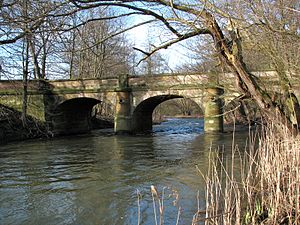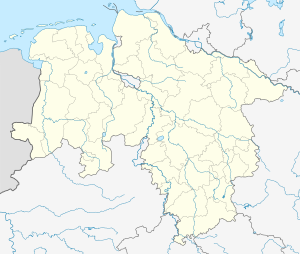Franzosenbrücke (Salzgitter)
Coordinates: 52 ° 1 ′ 32 ″ N , 10 ° 20 ′ 21 ″ E
| French Bridge | ||
|---|---|---|
| French Bridge | ||
| Convicted | District road 32 | |
| Subjugated | Innermost | |
| place | Salzgitter-Hohenrode | |
| Entertained by | City of Salzgitter | |
| Building number | SZ GI-3 | |
| construction | Arch bridge made of sandstone | |
| overall length | 32 m | |
| width | 6.75 m (between parapets) | |
| Number of openings | 3 | |
| Longest span | 3 × 5.80 m | |
| Clear height | 3.50 m | |
| completion | 1593 | |
| planner | Paul Francke | |
| location | ||
|
|
||
The Franzosenbrücke in the south of the city of Salzgitter is the larger of the two stone arch bridges that cross the Innerste and its tributary not far from the Hohenrode district . Both bridges were built for the first time in 1593, they connected the places grid and Lutter am Barenberge in the course of the then Frankfurter Heerstraße (Braunschweig-Seesen-Frankfurt) . Until 1965, the 248 federal highway ran from Braunschweig via Salzgitter-grid to Seesen .
construction of the bridge
The earliest tradition of building a bridge over the Innerste is known from a document from 1577. At that time, Duke Julius von Braunschweig-Wolfenbüttel ( reigned from 1568 to 1589) enfeoffed Rittmeister Carsten von Wobersnow with the Hohenrode estate . In return, Wobersnow had undertaken to build bridges over the two arms of the innermost at his own expense. Until his death, however, he had not kept this promise.
At that time there were only footbridges over the innermost, over which the river could only be crossed safely at low tide. The trigger for the construction of the bridge was probably an event in 1592, when the duke's carriage was overturned while crossing the innermost part of the river, which led to flooding. In the following year, 1593, the construction of bridges over the two arms of the river Innerste began. The builder was Duke Heinrich Julius von Braunschweig-Wolfenbüttel (reign from 1589 to 1613), the son of Duke Julius mentioned above. He had commissioned the ducal building director Paul Francke to be the master builder , who also built the Marienkirche in Wolfenbüttel , the Juleum in Helmstedt and the Salder Castle .
The bridge over the innermost should be built with two elongated vaults, the one over the parallel arm (Mühlengraben) with a vault. The Duke's stipulation was to build the bridges out of stone in order to "save a lot of wood", as there was a shortage of wood at the time due to the large amount of wood used by the Salzgitter saltworks . But when there were delays towards the end of the construction period, the building plan was changed and wooden planks were placed instead of the stone vaults.
The offices of Wohldenberg and Bilderlahe (near Seesen) have lists of the services provided . Wirschius, the abbot of the Ringelheim monastery , and Thedel von Wallmoden had promised to help with workers and wagons as residents . 12 monasteries from the surrounding area as well as 15 cities, e.g. B. Alfeld , Holzminden , Göttingen and Münden were involved in the bridge construction. The bridge was completed at the beginning of the winter of 1593.
Operation of the first bridge
During the Thirty Years' War the bridge was badly damaged by Tilly's mercenaries in 1625/26 , and in 1643 both bridges were destroyed by floods. In a later report to Duke August from around 1650 it says: The Innerstebrücken fell (destroyed). The road from lattice to Lutter can no longer be traversed because trees and bushes have grown on it.
It was not until 1707/08 that the bridges were rebuilt according to the old model. The cost of the bridge over the Innerste was borne by the von Wallmoden family, those of the bridge over the Mühlengraben were borne by the von Kniestedt family . After a flood in 1754, the bridge was only sparsely repaired, just as after the floods in 1761 and 1764 had caused severe damage.
During the French era , the French military road running from Kassel to Braunschweig led here over the Innerste. During a flood on April 6, 1808, the bridge collapsed when both pillars were damaged and the vaults were torn away by the tree trunks carried along by the flood. A repair was urgent because the military columns were jammed on the road from Kassel to Braunschweig and, moreover, a visit from King Jérôme to Braunschweig was scheduled for May 17th . With the help of French pioneers, local craftsmen managed to erect a wooden emergency bridge on the remains of the bridge piers in good time, so that the connection could be opened again in May 1808.
Since then the bridge has been called the Franzosenbrücke . On the one hand, because French troops were involved in the reconstruction and, on the other hand, because there was a French guardhouse in front of the bridge, which had been built to protect the bridge and where a road toll was levied on passers-by. This wooden emergency bridge was operated beyond the French era and was renovated in 1817 for 160 thalers, as can be seen from an inventory of the Liebenburg office on October 6, 1817.
Construction and operation of the second bridge
In 1818/19 the emergency construction of a stone bridge gave way, the construction was carried out under the direction of the Kingdom of Hanover . The bridge was extended by a third arch. Each of the three large basket arches had a clear width of 19½ feet and had a height of 8 feet above the sole at the top. The costs were estimated at 3,678 Reichstaler . Shortly before the end of 1819 the bridge was opened to traffic.
After a heat thunderstorm over the northwest Harz on June 29, 1861, the masses of water built up again at the Franzosenbrücke, which led to flooding in the surrounding area and made the road to Lutter impassable. The main cause was the narrow openings in the bridge. It was therefore decided to completely dismantle the existing stone bridge, to deepen the river bed by 5 feet and to rebuild the bridge with abutments raised by 4 feet . The keystone of the central arch of the bridge, which bears the date 1866, is a reminder of this renovation .
Extensive renovation work was carried out in 1987/88. The main measures included the expansion of the river bed to secure the foundation and the consolidation of the river bed, the securing of the pillars below and above the water surface, the repair of the sandstone material used and the restoration of the road surface. The estimated cost was DM 162,000.
During the renovation work carried out in 2004, the sandstone surfaces were repaired and damaged parapet walls and their covers were replaced.
Level markings
There is a level marking on the southern bridge pillar, divided into feet and inches. Measurements show that the foot here is 29.2 cm long. In particular, the division into 10 inches each instead of the usual 12 inches per foot indicates that this is probably an old Bavarian foot and inch measure . The adoption of the Bavarian dimensions dates from the time when the Wittelsbachers were not only the ruling princes of Bavaria, but also the electors of Cologne and thus rulers in the prince-bishopric of Hildesheim, to which the region belonged at the time.
Bridge over the Mühlengraben
In addition to the innermost, its side arm, today's Mühlengraben , had to be crossed with a bridge. This was also put into operation in 1593. After the unusually strong flood of February 5, 1775, this bridge collapsed and a new building was erected, which has been preserved to this day. The new bridge was built as a single arch bridge made of sandstone. It has a clear width of 5.20 m (roadway), a length of 6 m and a clear height of 2.50 m. At 245 years old (2020), this bridge is Salzgitter's oldest road bridge.
Usage today (2020)
With the relocation of federal highways 6 and 248 , two new bridges were built by the Wolfenbüttel district about 300 m south of Hohenrode in 1964/65 . The former B 248 was then downgraded to Kreisstraße 32. The old Franzosenbrücke and the neighboring bridge over the Mühlengraben will continue to be used for local traffic.
literature
- Klaus Gossow: Stone Bridges in Germany . Ed .: Federal Ministry of Transport -BMV-, Bonn. VBT-Verlag Bau und Technik, 1988, ISBN 978-3-7640-0240-4 , description of the Innerstebrücke Salzgitter-Hohenrode - Franzosenbrücke, p. 283-285 .
- Vera Schulz: Hohenrode - eight centuries . Ed .: Parish council of the Christ parish in Lattice and Hohenrode and volunteer fire brigade Hohenrode. 2001, ford and bridge construction, p. 77-81 .
Individual evidence
- ↑ Chronik Hohenrode from 2001, p. 81
- ↑ a b Bridge construction 400 years ago near Hohenrode by Hermann Bartels, Salzgitter-Zeitung of April 10, 1993
- ↑ Chronik Hohenrode from 2001, p. 78/79
- ↑ a b c d Bridges made of stones by Hermann Bartels, Salzgitter-Zeitung of December 21, 1993
- ↑ Chronik Hohenrode from 2001, p. 79
- ↑ Chronik Hohenrode from 2001, p. 79
- ^ A b Secret of the Franzosenbrücke revealed by Hermann Bartels, Salzgitter-Zeitung of January 5, 1988
- ↑ a b 175-year-old bridge with a rarity value from Hermann Bartels, Salzgitter-Zeitung from January 19, 1995
- ↑ a b Flood tore Innerstebrücke away from Hermann Bartels, Salzgitter-Zeitung of March 30, 1988
- ^ Inventory of the bridges in the Liebenburg Office from October 6, 1817, City of Salzgitter, Civil Engineering Office
- ^ Investigation report of the Landdrostei zu Hildesheim of July 23, 1862, City of Salzgitter, Civil Engineering Office
- ↑ Chronik Hohenrode from 2001, p. 81
- ^ Report from the engineering office commissioned with the renovation , April / May 1986, Stadt Salzgitter, civil engineering office
- ^ Bridge construction cost only 500 thalers in 1775 by Hermann Bartels, Salzgitter-Zeitung of September 27, 1990





